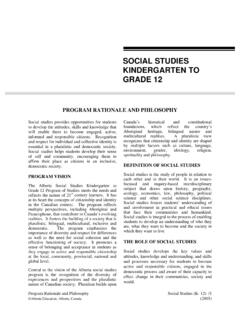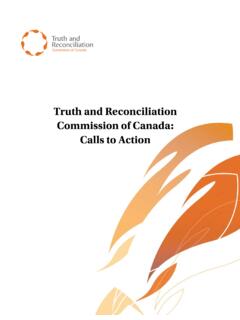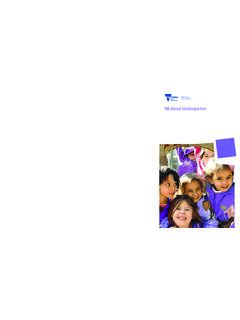Transcription of Learning about Aboriginal and Torres Strait Islander ...
1 VCAA Learning about Aboriginal and Torres Strait Islander histories and cultures Introduction Aboriginal and Torres Strait Islander cultures are the oldest, continuous cultures in the world, having existed in Australia for at least 50,000 years. The uniqueness of these cultures and the wisdom and knowledge embedded in them are things to be highly valued by all Victorians. The Victorian Curriculum includes the knowledge and skills students are expected to develop about Aboriginal and Torres Strait Islanders histories and cultures, given their particular and enduring importance. Protocols All teachers must follow the relevant protocols when teaching Aboriginal and Torres Strait Islander histories and cultures. The protocols provide guidelines about how to protect the integrity of Aboriginal and Torres Strait Islander cultural expressions and enable all Victorian teachers and students to engage respectfully and feel connected to this identity.
2 For advice, please refer to the Department of Education and Training's Koorie Cross-Curricular Protocols. Further advice is also available from the Victorian Aboriginal Education Association Inc., (VAEAI), who have produced Protocols for Koorie Education in Victorian Primary and Secondary schools. These protocols include advice to assist schools to provide a welcoming environment for Aboriginal community members and how to work respectfully with the Koorie community to enrich schools' teaching and Learning programs. Mapping the Victorian Curriculum F-10 content Below is a table that maps content descriptions that explicitly include references to Aboriginal and Torres Strait Islander histories and cultures, plus content descriptions whose elaborations also make explicit references.
3 Teachers can take the opportunity to explore these elaborations further as they highlight a range of approaches that could be used in the classroom to teach Aboriginal and Torres Strait Islander histories and cultures. The table is organised by curriculum areas beginning with Victorian Aboriginal Languages, which schools can offer as part of their Languages program. Given every content description in Victorian Aboriginal Languages is relevant, a single link has been provided to this curriculum area, rather than repeating them all. VCAA Mapping references to Aboriginal and Torres Strait Islander histories and cultures within the Victorian Curriculum Foundation to Level 2 Levels 3 and 4 Levels 5 and 6 Levels 7 and 8 Levels 9 and 10 Victorian Aboriginal Languages See the Victorian Aboriginal Languages curriculum: The Arts: Dance Foundation: Respond to dance, expressing what they enjoy and why (VCADAR020) Levels 1 and 2.
4 Respond to dance, expressing what they enjoy, and where and why people in their local area dance including dances of Aboriginal and Torres Strait Islander peoples (VCADAR024) Identify how the elements of dance and production elements express ideas in dance they make, perform and view including in dances from Aboriginal and Torres Strait Islander peoples (VCADAR028) Explain how the elements of dance and production elements communicate ideas in dances from different contexts they make, perform and view including in dances by Aboriginal and Torres Strait Islander peoples (VCADAR032) Analyse how choreographers use elements of dance and production elements to communicate intent (VCADAR038) Identify and connect specific features of dance from different times and locations including dance of Aboriginal and Torres Strait Islander peoples to explore viewpoints and enrich their dance making (VCADAR039) Analyse a range of dance from contemporary and past times, including dance of Aboriginal and Torres Strait Islander peoples, to explore differing viewpoints and develop understanding of dance practice across local, national and international contexts (VCADAR046) The Arts: Drama Foundation: Explore ideas for characters and situations through dramatic play (VCADRE017) Levels 1 and 2.
5 Respond to drama, expressing what they enjoy and why, and why people in their local area make and perform drama including drama of Aboriginal and Torres Strait Islander Peoples (VCADRR024) Shape and perform dramatic action using narrative structures and tension in devised and scripted drama (VCADRP027) Identify intended purposes and meaning of drama, including the drama of Aboriginal and Torres Strait Islander Peoples (VCADRR028) Perform devised and scripted drama that develops narrative and uses performance styles and design elements to engage an audience (VCADRP031) Explain how the elements of drama and production elements communicate meaning by comparing drama from different social, cultural and historical contexts including in the drama of Aboriginal and Torres Strait Islander Peoples (VCADRR032) Develop and refine expressive skills in voice and movement to communicate ideas and dramatic action in different performance styles and conventions (VCADRD036) Identify and connect specific features and purposes of drama from contemporary and past times, including the drama of Aboriginal and Torres Strait Islander peoples to explore viewpoints and enrich their drama making (VCADRR039)
6 Manipulate combinations of the elements of drama to develop and convey the physical and psychological aspects of roles and characters consistent with intentions in dramatic forms and performance styles (VCADRE041) Practise and refine the expressive capacity of voice and movement to communicate ideas and dramatic action in a range of forms, styles and performances spaces (VCADRD042) Analyse a range of drama from contemporary and past times, including the drama of Aboriginal and Torres Strait Islander peoples to explore differing viewpoints and develop understanding of drama practice across local, national and international contexts (VCADRR046) Learning about Aboriginal and Torres Strait Islander histories and cultures VCAA Page 3 Foundation to Level 2 Levels 3 and 4 Levels 5 and 6 Levels 7 and 8 Levels 9 and 10 The Arts: Media Arts Foundation: Respond to visual artworks and consider where and why people make visual artworks (VCAMAR020) Levels 1 and 2.
7 Create and present media artworks that communicate ideas and stories to an audience (VCAMAP023) Respond to media artworks and consider where and why people in their local area, including Aboriginal and Torres Strait Islander peoples, make media artworks (VCAMAR024) Identify intended purposes and meanings of media artworks considering who makes media artworks and the characteristics of audiences who view them in different social, historical and cultural contexts, including media artworks of Aboriginal and Torres Strait Islander peoples (VCAMAR028) Plan, produce and present media artworks for specific audiences and purposes using responsible media practice (VCAMAP031) Explain how the elements of media arts and story principles communicate meaning and viewpoints by comparing media artworks from different social, cultural and historical contexts, including media artworks of Aboriginal and Torres Strait Islander Peoples (VCAMAR032) Develop and refine media production skills using the technical and symbolic elements of images, sounds and text to represent a specific story, purpose and meaning (VCAMAM035) Present media artworks within different community and institutional contexts for different audiences, with consideration of ethical and regulatory issues (VCAMAP037)
8 Identify specific features and purposes of media artworks from contemporary and past times to explore viewpoints and enrich their media arts making, including those of Aboriginal and Torres Strait Islander peoples (VCAMAR039) Manipulate media representations to identify and examine social and cultural values and beliefs (VCAMAE041) Analyse and evaluate how technical and symbolic elements are manipulated in media artworks to challenge representations framed by social beliefs and values in different community and institutional contexts (VCAMAR045) Analyse and evaluate a range of media artworks from contemporary and past times, including the media artworks of Aboriginal and Torres Strait Islander peoples, to explore differing viewpoints and enrich their media arts making (VCAMAR046) The Arts: Music Foundation: Sing and play instruments to create and practise chants, songs and rhymes including those used by cultural groups in the local community (VCAMUM018) Levels 1 and 2.
9 Sing and play instruments to improvise, compose and practise a repertoire of chants, songs and rhymes, including those used by cultural groups in the local community (VCAMUM022) Respond to music, communicating their preferences and discussing where and why people in their local area make and perform music, including the music of Aboriginal and Torres Strait Islander peoples (VCAMUR024) Identify features of the music they listen to, compose and perform, and discuss the purposes it was created for including the music of Aboriginal and Torres Strait Islander peoples, using music terminology (VCAMUR028) Rehearse and perform songs and music they have learnt, including their own compositions, combining aspects of the elements of music and using performance skills, to communicate ideas and intentions to an audience (VCAMUP031) Explain how aspects of the elements of music are combined to communicate ideas, concepts and feelings by comparing music from different cultures, times and locations including the music of Aboriginal and Torres Strait Islander peoples (VCAMUR032) Identify and connect specific features and purposes of music from contemporary and past times including music of Aboriginal and Torres Strait Islander peoples, to explore viewpoints and enrich their music making (VCAMUR039)
10 Plan, develop and notate compositions with an understanding of style and convention (VCAMUM043) Analyse a range of music from contemporary and past times, including the music of Aboriginal and Torres Strait Islander Peoples to explore differing viewpoints, enrich their music making, and develop understanding of music practice in local, national and international contexts (VCAMUR046) Learning about Aboriginal and Torres Strait Islander histories and cultures VCAA Page 4 Foundation to Level 2 Levels 3 and 4 Levels 5 and 6 Levels 7 and 8 Levels 9 and 10 The Arts: Visual Arts Foundation: Respond to visual artworks and consider where and why people make visual artworks (VCAVAR020) Levels 1 and 2: Explore ideas, experiences, observations and imagination and express them through subject matter in visual artworks they create (VCAVAE021) Respond to visual artworks, including artworks by local Aboriginal and Torres Strait Islander peoples, by describing subject matter and ideas (VCAVAR024) Explore ideas and artworks from different cultures and times as inspiration to create visual artworks (VCAVAE025) Identify and discuss how ideas are expressed in artworks from a range of places, times and cultures, including artworks by Aboriginal and Torres Strait Islander peoples (VCAVAR028) Create and display art work considering how ideas can be expressed to an audience (VCAVAP031)







